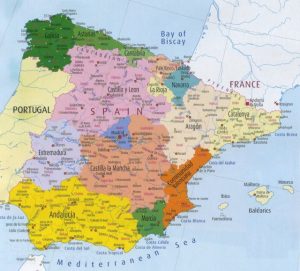Country of SW Europe, on the Iberian Peninsula, off the coast of Morocco in NW Africa. France is to the N across the Pyrenees Mountains, Portugal is to the W. At one time the most powerful nation in Europe and the center of a vast empire, Spain remains one of the poorest countries in Western Europe, despite the economic advances of recent years. The country has always been inhabited by people of many races, and this is mirrored in the rich diversity of its cultural heritage. On the other hand , Spanish history is stamped by the attempts of its rulers to unite the country, to channel the self-discipline and zeal of its people, to establish an orthodoxy and uniformity of thought, and to exert the authority of its central government, which even today is challenged by strong separatist movements. Madrid is the capital.
Spain’s Iberian population appeared as early as 8500 b.c. By 670 b.c. the Celts had occupied the northeast and had moved into the central plateau by 560 b.c. The country’s strategic importance on the Strait of Gibraltar has been recognized since antiquity, as were its deposits of tin and precious metals and its fertile fields. There were Phoenician colonies in Andalusia as early as the ninth century b.c. Celto- Iberian contact with them gave rise to the kingdom of Tartessus in the south between c. 650 and 550 b.c.
Between 500 b.c. and 220 b.c. the Greeks established some colonies, but Carthage extended its control over most of the southeastern peninsula. Eventually it came into conflict with Rome around the Ebro River and at the town of Saguntum (now Sagunto), a Greek colony allied with Rome. In the Second Punic War of 218 to 201 b.c. Carthage was finally dislodged from Spain. Rome occupied the south and east of the peninsula and gradually conquered Celtiberia of the center and north between 197 b.c. and 14 b.c.
The Scipios, Pompey, Caesar, and Augustus all advanced Roman control.
Under the Roman Empire Spain enjoyed prosperity, unity, and peace. It was divided into the Roman provinces of Baetica in the south and west, Tarraconensis in the north and east, and part of Lusitania in the west. Its population soon became romanized, and both the emperors Trajan and Hadrian were born here. The barbarian invasions saw the eruption of the Suevi, the Alans, and the Vand als from the north; but it was the Visigoths who emerged as masters of the peninsula in the sixth century a.d. They beat off both the Franks to the northeast and the Byzantine Empire in the south, which had reconquered most of Andalusia during a civil war in 554, and held on to portions of the southern coast until 631. The Visigothic Kingdom, ruling over a people of mixed cultural loyalties, at first established a centralized monarchy, with a uniform code of law and the support of the Catholic hierarchy. But disunity eventually set in, so that when the Moors invaded the country from Africa in 711, the kingdom collapsed.

With its capital at Cordoba, the Moorish Ummayad emirate conquered all of Spain except Asturias, from which emerged the kingdom of Galicia, the Carolingian Spanish March, and the Basque country. The March developed into the county of Barcelona by 900. It was these land s that were to form the nucleus for the Reconquista, the gradual Christian reconquest of Spain. The Moorish cities of Spain reached a high level of civilization, their chief cities of Cordova, Toledo, and Seville becoming famous throughout Europe for their learning and their industries and developing agricultural techniques of unparalleled efficiency.
By 925 the Kingdom of Leon had developed in the northwest. Navarre grew from the Basque country by 1000 and by 1037 Leon was conquered by Castile. By 1092 Aragon had united with Navarre, and by 1175 the country of Barcelona had merged into the kingdom of Aragon. With the collapse of the caliphate of Cordova in 1031, Muslim Spain disintegrated into several emirates, reunited by the Almoravids by 1110. The Almoravids were replaced from North Africa in 1145, by the Almohads. In 1212 Christian Spain, united under Castile, won a decisive victory over the Almohad dynasty at Las Navas de Tolosa, leaving only the emirate of Granada in Moorish hand s. The Christian position was consolidated further by the union of the kingdoms of Leon and Castile in 1230 and by the union of Aragon and Castile in 1479. Meanwhile, Aragon extended its rule eastward to Sardinia in 1323, the Balearic Island s in 1349, Sicily in 1409, and finally Naples in 1435 and 1442.
Spain was united under Ferdinand II of Aragon and Isabella of Castile in 1469. With the fall of Granada in 1492 the reconquest was complete, and in the same year Columbus discovered America. With the ensuing flow of wealth from the New World in the 16th century, Spain became the foremost power in Europe with a vast overseas empire and with substantial territories in Europe, acquired after the crowning of the Hapsburg heir to Spain, Charles I, as Holy Roman Emperor Charles V in 1519. The 16th century also saw the increasing power of the Counter- Reformation and the Inquisition. Despite the War of the Comunidades of 1520 to 1521, a rebellion in which the cities attempted unsuccessfully to retain their autonomy against the centralizing policies of Charles V, Spain became the bulwork of Catholicism and of Christianity, supplying men and treasure against Protestants and Turks.
The period from 1550 to 1650 has been called the Golden Age (siglo de oro) for Spain. Under Charles V and Philip II (1556–98) Spain saw its domains stretch from Sicily to the Netherland s and , while Philip’s marriage to Queen Mary of England was recognized, to England . Its realm also included all of the Americas from the Rio de La Plata to Chile, from Peru to Colorado and across the Pacific to the Philippines. It also included any English claims in North America during Philip’s marriage to Mary.
This was also the age of Ignatius Loyola, of Cervantes, Murillo, Velasquez, Lope de Vega, and Suarez.
Until 1567 Catholic Spain held the initiative in Europe. At Lepanto in 1571 it led the Christian fleet that defeated the Turks. At the Massacre of St. Bartholomew in France in 1572 it rejoiced at the defeat of the Protestants. But already in the reign of Philip II Spain faced repeated bankruptcies. Continued revolt in the Spanish Netherland s from 1566 to 1579 and the disastrous defeat of the Spanish Armada in 1588 by England proved a great drain on an economy already undermined by the overextension of agricultural land to sheep raising, the misguided expulsion of the Jews (1492) and Moors (1609) and the flight of the riches of the New World to northern mercantile countries. After the Thirty Years’ War of 1618 to 1648 it was France that emerged as master of Europe.
Annexed by Spain in 1580, Portugal became independent in 1640. France took the Franche-Comte in 1678; and in the War of the Spanish Succession of 1702 to 1713, Spain passed to the Bourbons of France. For a time it was torn by civil war, and it lost many of its European territories, including Gibraltar and Minorca to Great Britain, Milan, Naples, and Sicily to Austria; and Sardinia to Savoy.
Although reforms were introduced in the 18th century, Spain’s position remained weak. The Bourbons regained the separate kingdom of the Two Sicilies from Austria in the War of the Polish Succession.
Spain also aided the colonies in the American Revolution. In 1808, having placed his brother Joseph on the Spanish throne, Napoleon occupied Spain. In the Peninsular Campaign the British under Wellington were aided by Spanish insurgents, who fought behind the lines in “small wars” from which we get the term guerrillas. They forced the French out of Spain by 1814. In 1812 a new liberal constitution was drawn up in Cadiz. After the war, however, the nationalist and liberal aspirations of the war years flared again in 1820 but were stifled by a period of reactionary government. In 1823 the Conservatives welcomed a French invasion to reestablish their rule. By 1825 Spain had finally lost most of her American empire, and on the death of Ferdinand VII in 1833 the first of the dynastic Carlist Wars of 1833 to 1839 split the country. After peace was restored, Spanish politics remained dogged by instability throughout the 19th century, with left-wing and separatist movements increasingly active, especially in Catalonia and the Basque Provinces. The Spanish- American War of 1898 brought further setbacks abroad with the loss of Cuba, Puerto Rico, and the Philippine Island s.
Spain remained neutral during World War I but was plunged into civil war in 1936 following a rightwing military uprising under General Francisco Franco. Aided by the fascist governments of Italy and Germany, Franco unleashed the developing technology of World War II in fascist aerial bombings of Madrid and Barcelona. He forced the Loyalist government to surrender in 1939 and established a dictatorship.
Over 600,000 Spanish died in the war, which left bitter feelings for two generations. Despite Spain’s neutrality in World War II, the Western powers were reluctant to recognize the legitimacy of its fascist government, and it was not until 1955 that Spain was admitted to the United Nations. However, despite the oppressive regime of the postwar years, Spain made considerable economic progress under Franco. With his death in 1975, the monarchy was reestablished under Juan Carlos, who has steered a course toward constitutional government and gradual liberalization through Spain’s volatile political scene. In June 1977 a centrist government under Adolfo Suarez was elected. In December 1978 Spain’s parliament






